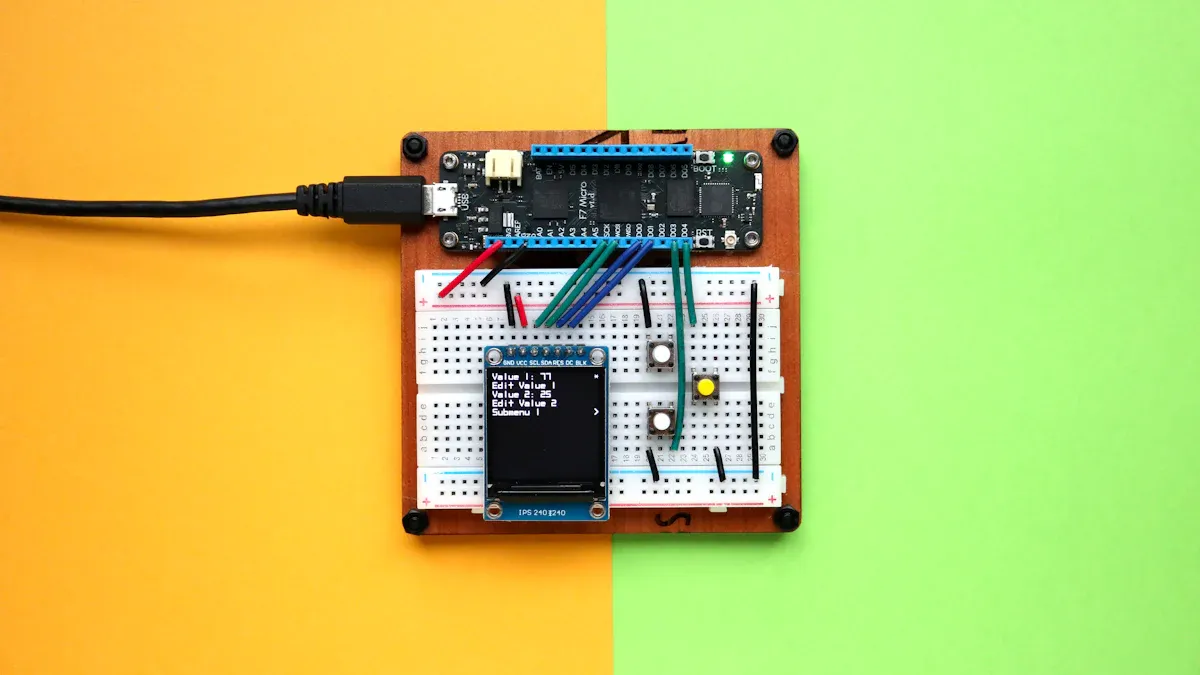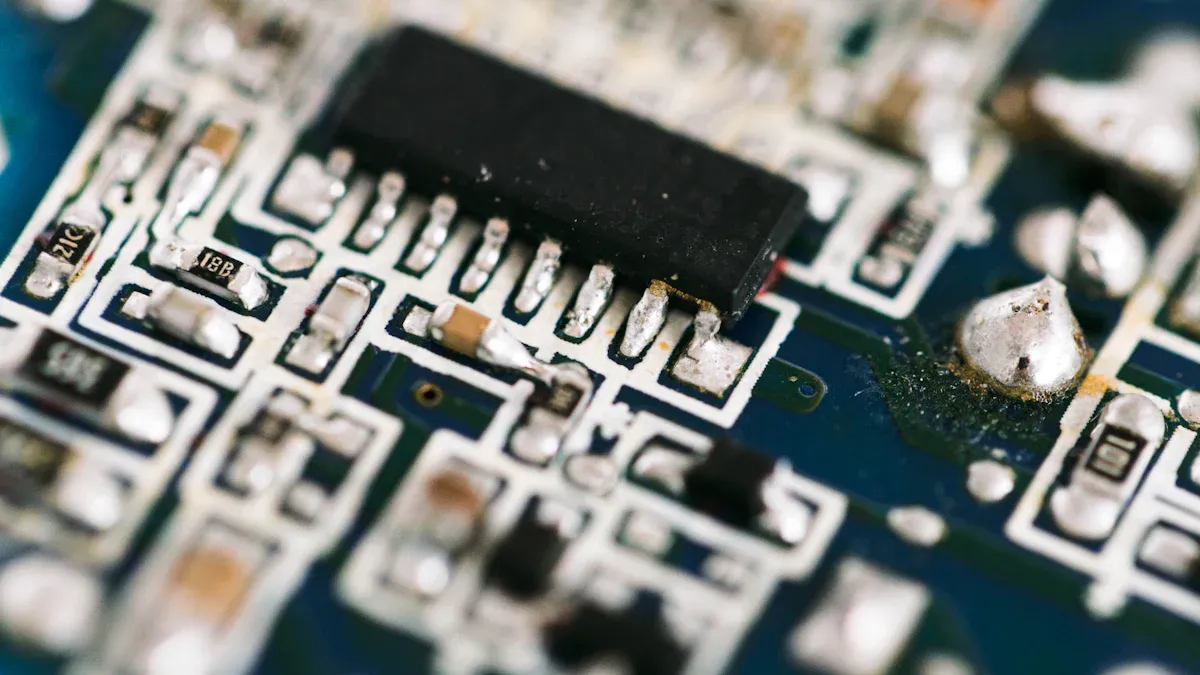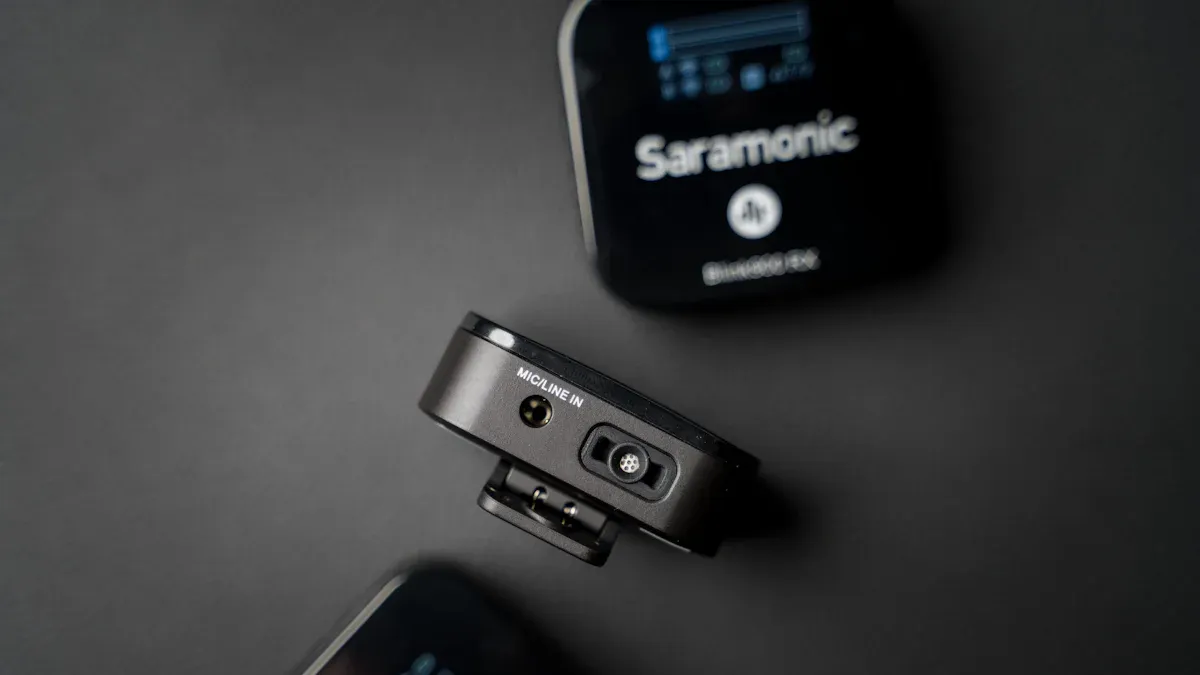How Audio Transmitter Chips Work and Where They Are Used

An AUDIO TRANSMITTER chip takes audio signals and sends them wirelessly to other devices. This chip allows headphones, speakers, and even car audio systems to receive sound without wires. Many consumer electronics rely on this technology for convenience and flexibility.
People want high-quality, portable audio, and manufacturers use these chips to meet that demand.
Aspect | Details |
|---|---|
Bluetooth dominates portable and entertainment devices like earbuds and headphones. | |
Consumer Preferences | More users seek lossless audio and wireless solutions for on-the-go listening. |
Emerging Trends | Gaming, VR, and smart features drive new uses for wireless audio transmitters. |
Key Takeaways
Audio transmitter chips send sound wirelessly by converting audio signals into digital data and broadcasting them through methods like Bluetooth, FM, or infrared.
These chips power many devices such as wireless headphones, speakers, car audio systems, microphones, and some toys, offering convenience without cables.
Bluetooth is the most common transmission method, providing good sound quality and low delay for everyday listening and portable devices.
Choosing the right chip depends on factors like sound quality, signal range, latency, and how easily it fits into the device’s design and power needs.
Understanding how these chips work helps users pick the best option for clear, reliable wireless audio in their gadgets and projects.
AUDIO TRANSMITTER Chip Basics

What It Is
An AUDIO TRANSMITTER chip is a small electronic component that sends sound signals from one device to another without using wires. This chip takes the audio from a source, such as a phone or computer, and prepares it for wireless transmission. Many modern gadgets, like wireless headphones and speakers, use this chip to deliver clear sound without the need for cables.
The chip often sits inside devices that need to send audio to other equipment. For example, a TV with built-in wireless audio can use this chip to send sound directly to a Bluetooth speaker. The chip handles the technical work of turning sound into a signal that travels through the air.
Key Functions
The AUDIO TRANSMITTER chip performs several important tasks to make wireless audio possible:
It captures audio signals from the device.
It converts these signals into a digital format that can travel wirelessly.
It uses special methods, such as Bluetooth or FM, to send the audio to another device.
It manages the quality of the sound, making sure voices and music stay clear.
Many chips come with advanced features to improve performance. Some support the latest Bluetooth versions, like v5.3 and v5.2, which help with faster and more stable connections. Others include powerful audio processors, such as Qualcomm Kalimba DSPs running at dual 120 MHz clock speeds. These processors help the chip handle complex audio tasks quickly.
AUDIO TRANSMITTER chips often support a range of audio codecs, including aptX, aptX HD, aptX-ll, and aptX-ad. These codecs help keep the sound quality high, even when sending audio wirelessly. The chips also work with different Bluetooth profiles, such as A2DP for music streaming and HFP for hands-free calls. Many chips meet strict certifications, like BQB, TELEC, and CE, to ensure they work safely and reliably in many countries.
Note: The technical specifications of each chip can affect how well it works in different devices. Users should check these details when choosing a chip for their needs.
How They Work
Signal Conversion (ADC)
An AUDIO TRANSMITTER chip starts by capturing sound from a source, such as a microphone or audio player. This sound exists as an analog signal, which means it has a continuous wave shape. The chip uses a part called an analog-to-digital converter (ADC) to change this analog signal into digital data. The ADC samples the sound many times each second. For example, if the highest sound frequency is 8,000 Hz, the chip samples at least 16,000 times per second. This process creates a series of numbers that represent the sound.
The chip also decides how many bits to use for each sample. More bits mean better sound quality because the chip can capture more detail. After conversion, the chip may compress the digital audio to make it smaller and easier to send. It can also add error correction codes to help fix any mistakes that happen during transmission.
Tip: Higher sampling rates and more bits per sample give clearer audio, but they also use more power and bandwidth.
Modulation & Transmission
Once the AUDIO TRANSMITTER chip has digital audio data, it prepares the data for wireless transmission. The chip uses a modulator to put the digital data onto a carrier wave. This carrier wave is a steady signal, often made by a quartz crystal oscillator, that the chip can change in different ways. The modulator can change the wave’s amplitude, frequency, or phase to carry the audio information.
Common modulation types include:
Amplitude Modulation (AM)
Frequency Modulation (FM)
Frequency Shift Keying (FSK) for digital signals
Orthogonal Frequency-Division Multiplexing (OFDM) for high-speed data
The chip adds headers and error correction to the data stream. Then, it sends the modulated signal to an antenna. The antenna broadcasts the signal as electromagnetic waves. Automatic gain control (AGC) helps keep the signal strength steady, even if the input sound gets louder or softer.
Steps in the process:
The chip converts analog audio to digital.
It compresses and encodes the audio.
It adds error correction and headers.
The modulator puts the data onto a carrier wave.
The antenna sends the signal wirelessly.
Bluetooth, FM, and IR Methods
AUDIO TRANSMITTER chips use different wireless methods to send audio. The three most common are Bluetooth, FM, and infrared (IR). Each method has its own strengths and weaknesses.
Transmission Method | Frequency Band / Medium | Data Rate (Throughput) | Range | Interference Handling | Latency | Notes |
|---|---|---|---|---|---|---|
Bluetooth | 2.4 GHz ISM band | ~10 m | Adaptive Frequency Hopping | ~2.5 ms | Low power, supports many devices | |
FM | VHF band (e.g., 81.3 MHz) | Not specified | Longer than Bluetooth | Frequency hopping, binary FM | N/A | Good for longer range, can have interference |
IR (Infrared) | Light-based, line-of-sight | Up to 1 Gbit/s (raw) | Very short, line-of-sight | Minimal, affected by bright light | ~25 ms | High speed, but needs clear path |
Bluetooth is the most popular choice for portable devices. It works in the 2.4 GHz band and uses frequency hopping to avoid interference. Bluetooth can send both music and voice, and it keeps latency low, which means there is little delay between sending and receiving sound.
FM transmission uses radio waves in the VHF band. It can cover longer distances than Bluetooth, but it may face more interference from other signals. FM is often used in car audio systems and some wireless microphones.
IR transmission uses light instead of radio waves. It can send data very quickly, but it only works over short distances and needs a clear line of sight. IR is less common in modern audio devices but still appears in some remote controls and toys.
Note: The choice of transmission method depends on the device’s needs. Bluetooth works well for headphones and speakers. FM suits longer-range uses, such as car audio. IR fits simple, short-range links.
Applications

Wireless Headphones & Speakers
Wireless headphones and speakers use an AUDIO TRANSMITTER chip to send sound from a phone, tablet, or computer. The chip changes the audio into a signal that travels through the air. People can listen to music or watch videos without any wires. Many headphones use Bluetooth to connect quickly and keep the sound clear. Some speakers also use this chip to play music from different rooms in a house.
Tip: Bluetooth headphones with advanced chips often have less delay, so voices and music match the video better.
Car Audio & TV Streaming
Many cars now let drivers play music from their phones without plugging in a cable. The AUDIO TRANSMITTER chip sends the sound to the car’s speakers using Bluetooth or FM signals. This makes it easy to switch songs or take calls while driving. TVs also use these chips to send audio to wireless soundbars or headphones. People can watch shows late at night without waking others.
Device Type | Typical Transmission Method | Benefit |
|---|---|---|
Car Audio | Bluetooth, FM | Hands-free, easy pairing |
TV | Bluetooth | Private listening |
Wireless Microphones & Toys
Wireless microphones use transmitter chips to send voices to speakers or recording devices. Singers, teachers, and presenters can move around freely. Many toys also use these chips to play sounds or music without wires. For example, some remote-control cars play engine sounds through a wireless speaker.
Industrial & Embedded Uses
Factories and offices use AUDIO TRANSMITTER chips in machines and control panels. These chips help send alerts or instructions to workers without cables. Some medical devices use wireless audio to send signals to hearing aids or monitors. Engineers also put these chips in robots and smart home devices to make them easier to control.
Note: Choosing the right chip helps each device work better in its environment.
Choosing an AUDIO TRANSMITTER Chip
Selecting the right AUDIO TRANSMITTER chip helps devices deliver clear, reliable sound. Shoppers and engineers should look at several important factors before making a choice.
Latency & Audio Quality
Latency means the delay between sending and receiving sound. Low latency is important for live music, gaming, and video calls. High audio quality means the sound stays crisp and detailed. Industry standards show that professional audio needs latency as low as 1 millisecond. Most wireless systems, like Bluetooth, cannot reach this level, but they work well for everyday listening.
Aspect | Industry Standard / Requirement | Example or Explanation |
|---|---|---|
Latency | Needed for concerts and stage performances | |
Audio Quality | High dynamic range (>150 dB) | Clear sound, even in noisy places |
Reliability | No errors at the start of the audio | Important for microphones and in-ear monitors |
Tip: For music and movies, look for chips that support high-quality codecs and low-latency modes.
Range & Compatibility
Range tells how far the signal can travel. Bluetooth usually covers about 10 meters, while FM can reach farther. Compatibility means the chip works with many devices, like phones, TVs, or speakers. Some chips handle different Bluetooth versions or support both FM and Bluetooth. This flexibility helps users connect to more devices.
Bluetooth: Good for short distances and easy pairing.
FM: Better for longer distances, such as car audio.
IR: Works for short, direct connections.
Note: Always check if the chip matches the devices you want to use.
Setup & Integration
Setup should be simple. Many chips come with built-in antennas and easy pairing features. Integration means the chip fits well inside the device and works with its battery and controls. Some chips save power by turning off parts they do not need. Fast wake-up times help devices respond quickly.
Look for chips with clear instructions and support for your device’s operating system.
Choose chips with power-saving features for portable gadgets.
Matching the chip’s features to the use case makes a big difference. Bluetooth chips work best for headphones and speakers. FM chips suit car audio and longer-range needs. IR chips fit toys and remote controls.
An AUDIO TRANSMITTER chip sends sound wirelessly between devices. This chip changes audio signals into a form that travels through the air. People find these chips in headphones, speakers, cars, and toys. Understanding how these chips work helps buyers pick the right one for their needs. Readers should think about sound quality, range, and setup before choosing a chip for any project.
FAQ
What devices use audio transmitter chips?
Audio transmitter chips appear in wireless headphones, speakers, car audio systems, microphones, and some toys. Many TVs and computers also use these chips to send sound without wires.
Can audio transmitter chips work with any Bluetooth device?
Most chips support common Bluetooth profiles, so they connect with many devices. Users should check the chip’s version and supported profiles to make sure it matches their headphones or speakers.
How far can an audio transmitter chip send sound?
Bluetooth chips usually send sound up to 10 meters. FM chips can reach farther, sometimes over 30 meters. Walls and other objects may reduce the range.
Do audio transmitter chips affect sound quality?
Audio transmitter chips can keep sound clear if they use good codecs and high sampling rates. Some chips support advanced features for better music and voice quality.
See Also
Understanding Current-Loop Transmitter Chips And Their Functionality
A Comprehensive Guide To Communication Chips And Operations
Exploring IC Audio Signal Processors And Their Main Characteristics
Isolation Amplifier IC Chips: Functions And Practical Applications
An Overview Of IC Voice Processors And Their Working Principles
